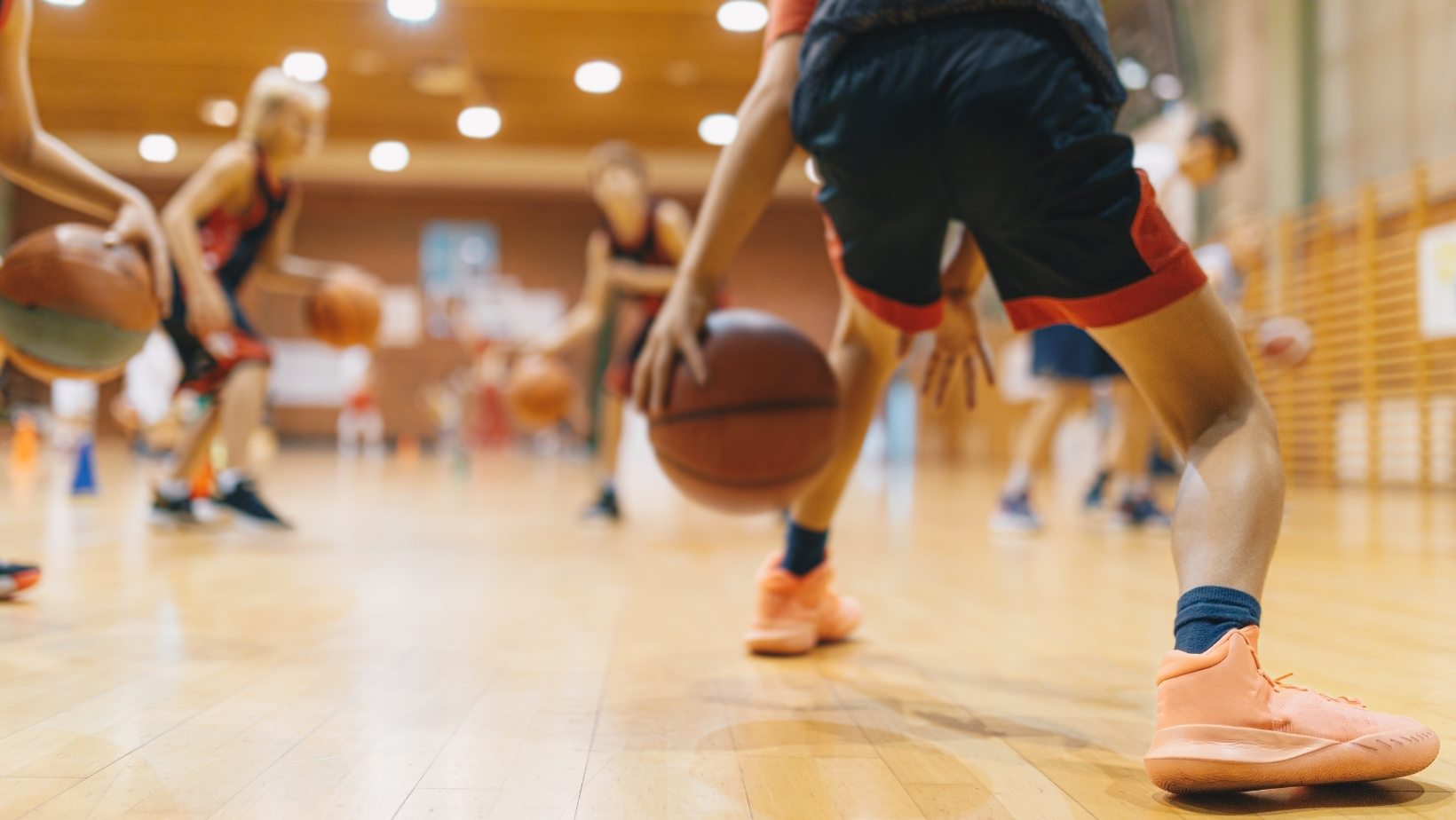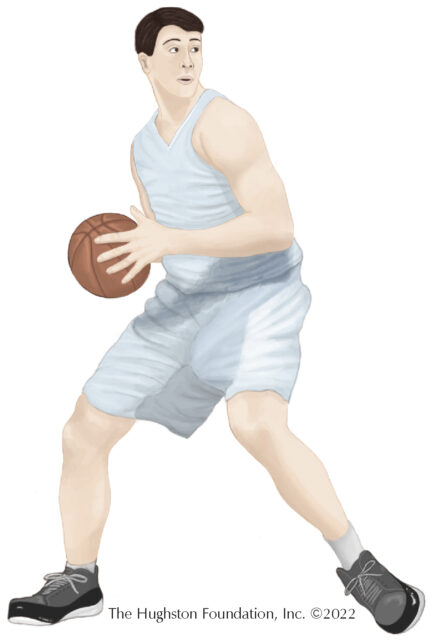
Basketball, a popular sport worldwide, is played domestically and internationally by over 2 billion athletes of all ages and abilities. The sport involves agility with quick changes in speed, pivoting, and diverse jumping, which is why basketball injuries tend to affect the lower extremity and involve the knee and ankle.1 Most of these lower extremity musculoskeletal injuries are noncontact and often are overuse injuries, strains, sprains, or ruptures of the soft tissues.
Knee injuries
With sports and fitness activities, there is always a chance of injury and basketball is no exception. The knee, the largest joint in the human body, is composed of the distal femur (thighbone), patella (kneecap), and the proximal tibia (shinbone). Ligaments are tough connective tissue that connects bones to each other and allow structural support while maintaining slight elasticity for movement; and tendons are tough, white fibrous tissues that connect muscle to bone (Fig. 1). When a muscle contracts, it pulls on its associated tendon which then moves the bone. An overuse injury occurs when you subject a muscle, tendon, ligament, or joint to constant stress. The severity of these injuries varies from mild strains (injury to a muscle or its tendon), or sprains (injury to a ligament), to complete tears of the ligaments and other soft tissue structures of the knee.
Patellar tendinitis, also called “jumper’s knee,” is a common basketball strain of the patellar tendon that attaches the patella to the shinbone. When a person has jumper’s knee, there is inflammation of the patellar tendon, which can lead to pain in the anterior (front) compartment of the knee. The inflammation can cause the patient to feel sore after physical activity, and if left untreated can lead to swelling, microtears, and eventual degeneration of the anterior compartment of the knee.
Another common injury in basketball that occurs inside the knee joint is a torn meniscus. There are 2 menisci inside the knee joint, the medial meniscus (C-shaped) and the lateral meniscus (U-shaped). These serve as knee “shock absorbers,” transferring weight and force from the thigh to the lower leg. In basketball, quick explosive movements can lead to twisting and turning of the knee joint, which is a common mechanism of injury for a torn meniscus.2 Patients who suffer from this injury usually describe a clicking sensation accompanied with pain, swelling, and stiffness. While some meniscal tears can heal by conservative measures, others may need a procedure to include meniscal repair or partial meniscectomy. During the procedure, the surgeon repairs or removes the damaged cartilage. Research has shown that this surgery has minimal effect on physical performance in professional athletes upon full recovery.2
Ankle injuries
The ankle is composed of the distal tibia (shinbone), the fibula (smaller bone of the lower leg), and the talus, which is between the leg and foot bones (Fig. 2). Although the ankle undergoes tremendous amounts of stress, ligaments on both sides help to stabilize it. Ankle injuries are considered to be the most common basketball injury.1,2 Many basketball maneuvers such as pivoting, make ankle injuries common; in fact, it is the leading cause of injury (13.2%) for NBA players in a 17-year research study.1 Another study reports that basketball ankle injuries occur at a rate of 3.5 out of 1000 instances, with most of the injuries occurring while landing from a vertical jump.3 Lateral ankle sprains are the most common, especially to the anterior talofibular ligament. An injury to this particular ligament is often caused by an inversion injury, where the foot rolls inward causing damage to the ligaments on the outside of the foot. Ankle injuries are not usually a single occurrence, data shows that a basketball player that develops an ankle sprain is 5 times more likely to develop another one.3 Due to the increased risk of injury after an initial ankle sprain, players try to lower their risk by stabilizing the ankle joint with an ankle brace or with taping.
Achilles injuries
The Achilles tendon is the strongest tendon in the human body. It connects the calf muscles (gastrocnemius and soleus) to the posterior side of the calcaneus bone (heel bone). This tendon allows calf muscles to exert force and dorsiflex the foot (push the foot and toes downward). Basketball players are always moving and exerting force from the feet, such as jumping, running, and pivoting, which causes injury to the Achilles tendon. Physicians classify the mild version of injury to the Achilles tendon as Achilles tendinitis. In Achilles tendinitis, the tendon becomes inflamed and irritated, leading to pain and stiffness. This injury develops over time, which classifies it as an over-use injury.
The severe version of this injury is an Achilles tear, usually arising from a traumatic tendon tear due to sudden increase in tendon force and loading. For professional athletes, this type of injury often needs surgical intervention; but unfortunately, it does not have a favorable prognosis.4,5 After suffering an Achilles tendon tear, athletes average missing 10 months of competitive basketball while having surgery and undergoing physical rehabilitation.6 Additionally, research shows that competitive basketball players who suffered an Achilles tendon tear ended up having a shorter career afterwards in comparison with other players who did not suffer the injury.6
 Treatment and prevention
Treatment and prevention
As with most musculoskeletal injuries, the best treatment is prevention. Adequate stretching and warming up prior to physical activity is key to prevent the injuries. Conditioning for athletes also play a crucial role in the prevention of overuse injuries. Athletes must gradually ramp up their exercise routine so that their tendons and ligaments become adapted to the new physical stress placed upon them.
Initially, conservative treatment for athletes who suffer lower extremity musculoskeletal injuries, such as sprains, include following the RICE regimen (rest, ice, compression, elevation), NSAID’s (non-steroidal anti-inflammatory medication), and bracing or splinting. Once the inflammation and pain decreases, the athlete can begin a rehabilitation routine that focuses on stretching and strengthening. As the injury improves, the athlete can slowly begin a conditioning period before returning to the prior vigorous training routine.
Author: Carlos Diaz | Columbus, Georgia
References
- Drakos MC, Domb B, Starkey C, et al. Injury in the national basketball association: a 17-year overview. Sports Health. 2010 Jul;2(4):284-90.
- Zedde P, Mela F, Del Prete F, et al. Meniscal injuries in basketball players. Joints. 2015 Feb 13;2(4):192-6.
- McKay GD, Goldie PA, Payne WR, Oakes BW. Ankle injuries in basketball: injury rate and risk factors. Br J Sports Med. 2001 Apr;35(2):103-8.
- Trofa DP, Miller JC, Jang ES, et al. Professional athletes’ return to play and performance after operative repair of an Achilles tendon rupture. Am J Sports Med. 2017;45:2864-2871.
- Khalil LS, Jildeh TR, Tramer JS, et al. Effect of Achilles Tendon Rupture on Player Performance and Longevity in National Basketball Association Players. Orthop J Sports Med. 2020 Nov 30;8(11):2325967120966041.
- Alegre B, Seijas R, Alvarez P, Pérez A. The Achilles Tendon Rupture in Basketball: Systematic Review of the Present Literature. Surg J (NY). 2021 Sep 14;7(3):e265-e270.
Last edited on November 29, 2023